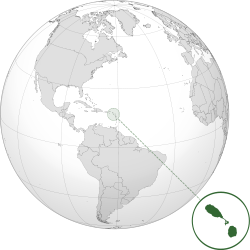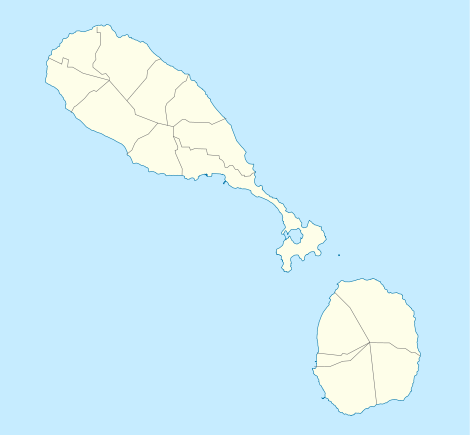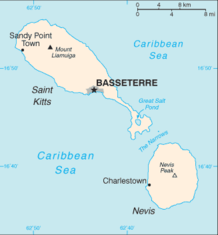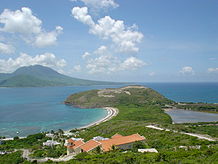
Saint Kitts and Nevis
Did you know...
SOS Children have produced a selection of wikipedia articles for schools since 2005. Sponsoring children helps children in the developing world to learn too.
| Federation of Saint Kitts and Nevisa | ||||||
|---|---|---|---|---|---|---|
|
||||||
| Motto: "Country Above Self" | ||||||
| Anthem: O Land of Beauty! Royal anthem: God Save the Queen |
||||||
|
|
||||||
| Capital and largest city |
Basseterre 17°18′N 62°44′W |
|||||
| Official languages | English | |||||
| Ethnic groups (2000) |
|
|||||
| Demonym | Kittitian or Nevisian | |||||
| Government | Parliamentary democracy under federal constitutional monarchy |
|||||
| - | Queen | Elizabeth II | ||||
| - | Governor General | Edmund Lawrence | ||||
| - | Prime Minister | Denzil Douglas | ||||
| Legislature | National Assembly | |||||
| Independence | ||||||
| - | from the United Kingdom | 19 September 1983 | ||||
| Area | ||||||
| - | Total | 261 km2 ( 207th) 104 sq mi |
||||
| - | Water (%) | negligible | ||||
| Population | ||||||
| - | July 2005 estimate | 51,300 ( 209th) | ||||
| - | Density | 164/km2 ( 64th) 424/sq mi |
||||
| GDP ( PPP) | 2011 estimate | |||||
| - | Total | $895 million | ||||
| - | Per capita | $15,573 | ||||
| GDP (nominal) | 2011 estimate | |||||
| - | Total | $715 million | ||||
| - | Per capita | $12,728 | ||||
| HDI (2007) | high · 62nd |
|||||
| Currency | East Caribbean dollar ( XCD) |
|||||
| Time zone | ( UTC-4) | |||||
| Drives on the | left | |||||
| Calling code | +1 869 | |||||
| ISO 3166 code | KN | |||||
| Internet TLD | .kn | |||||
| a. | Or "Federation of Saint Christopher and Nevis". | |||||
The Federation of Saint Kitts and Nevis ( / s eɪ n t ˌ k ɪ t s æ n d ˈ n iː v ɪ s /; also known as the Federation of Saint Christopher and Nevis), located in the Leeward Islands, is a federal two-island state in the West Indies. It is the smallest sovereign state in the Americas, in both area and population.
The capital city and headquarters of government for the federated state is Basseterre on the larger island of Saint Kitts. The smaller island of Nevis lies about 2 miles (3 km) southeast of Saint Kitts, across a shallow channel called "The Narrows".
Historically, the British dependency of Anguilla was also a part of this union, which was then known collectively as Saint Christopher-Nevis-Anguilla. Saint Kitts and Nevis are geographically part of the Leeward Islands. To the north-northwest lie the islands of Sint Eustatius, Saba (the Netherlands), Saint Barthélemy, Saint-Martin/Sint Maarten and Anguilla. To the east and northeast are Antigua and Barbuda, and to the southeast is the small uninhabited island of Redonda, and the island of Montserrat, which currently has an active volcano (see Soufrière Hills).
Saint Kitts and Nevis were among the first islands in the Caribbean to be settled by Europeans. Saint Kitts was home to the first English and French colonies in the Caribbean, and thus has also been titled "The Mother Colony of the West Indies".
Etymology
Saint Kitts was named " Liamuiga" by the Kalinago Indians who inhabited the island. This name, roughly translated, in English means "fertile land," a testimony to the island's rich volcanic soil and high productivity.
Nevis's pre-Columbian name was "Oualie," which translates to "land of beautiful waters," presumably referring to the island's many freshwater springs and hot volcanic springs.
Christopher Columbus, upon sighting what we now call Nevis in 1493, gave that island the name San Martin (Saint Martin). However, the confusion of numerous, poorly charted small islands in the Leeward Island chain, meant that the name ended up being accidentally transferred to another island, the one which we now know as the French/Dutch island Saint-Martin/Sint Maarten.
The current name "Nevis" is derived from a Spanish name Nuestra Señora de las Nieves (The original name was the archaic Spanish "Noestra Siñora delas Neves"), by a process of abbreviation and anglicisation. This Spanish name means Our Lady of the Snows. It is not known who chose this name for the island, but it is a reference to the story of a fourth-century Catholic miracle: a snowfall on the Esquiline Hill in Rome. Presumably the white clouds which usually wreathe the top of Nevis Peak reminded someone of the story of a miraculous snowfall in a hot climate. The island of Nevis, upon first British settlement, was referred to as "Dulcina," a name meaning "sweet one." Its original Spanish name, "Nuestra Señora de las Nieves," was eventually kept however, though it was soon shortened to "Nevis."
There is some disagreement over the name which Columbus gave to St. Kitts. For many years it was thought that he named the island San Cristobal, after his patron saint Saint Christopher, the saint of travelling. However, new studies suggest that Columbus named the island Sant Yago (Saint James). The name "San Cristobal" was apparently given by Columbus to the island now known as Saba, 20 miles northwest. It seems that "San Cristobal" came to be applied to the island of St. Kitts only as the result of a mapping error.
No matter the origin of the name, the island was well documented as "San Cristobal" by the 17th century. The first English colonists kept the English translation of this name, and dubbed it "St. Christopher's Island." In the 17th century Kit, or Kitt, was a common nickname for the name Christopher, and so the island was often informally referred to as "Saint Kitt's island," which was further shortened to "Saint Kitts."
Today, the Constitution refers to the state as both "Saint Kitts and Nevis" and "Saint Christopher and Nevis," but the former is the one most commonly used.
History
Five thousand years prior to European arrival, the island was settled by Native Americans. The last wave of Native American arrivals, the Kalinago people, arrived approximately three centuries before the Europeans. The islands were discovered by the Europeans through a Spanish expedition under Columbus in 1493. In 1538, French Huguenots established a settlement on St. Kitts but the settlement was destroyed by the Spanish soon afterwards and the survivors were deported. In 1623, an English settlement was established, which was soon followed by French settlements, the island being divided by agreement. Dissimilar to many other islands, the local Kalinago people on the island allowed Europeans to colonise Saint Kitts. In 1626, the Anglo-French settlers massacred the Kalinago.
A Spanish expedition, sent to enforce Spanish claims, destroyed the English and French colonies and deported the settlers back to their respective countries in 1629. As part of the war settlement in 1630, the Spanish permitted the re-establishment of the English and French colonies.
As Spanish power went into decline, Saint Kitts became the premier base for English and French expansion into the Caribbean, as the islands of Antigua, Montserrat, Anguilla and Tortola for the English, and Martinique, the Guadeloupe archipelago and St. Barts for the French were colonised from it. During the late 17th century, France and England battled for control over St Kitts. It was ceded to Britain in 1713.
Although small in size, and separated by only 2 miles (3 km) of water, the two islands were viewed and governed as different states until the late 19th century, when they were forcibly unified along with the island of Anguilla by the British. To this day relations are strained, with Nevis accusing Saint Kitts of neglecting its needs.
Saint Kitts and Nevis, along with Anguilla, became an associated state with full internal autonomy in 1967. Anguillians rebelled, and separated from the others in 1971. St. Kitts and Nevis achieved independence in 1983. It is the newest sovereign state in the Americas. In August 1998, a vote in Nevis on a referendum to separate from St. Kitts fell short of the two-thirds majority needed. In late September 1998, Hurricane Georges caused approximately $458,000,000 in damages and property and limited GDP growth for the year and beyond. Georges was the worst hurricane to hit the region in the century.
Politics
Saint Kitts and Nevis is a sovereign, democratic and federal state. The Queen of Saint Christopher and Nevis, Elizabeth II is its head of state. The Queen is represented in the country by a Governor-General, who acts on the advice of the Prime Minister and the Cabinet. The Prime Minister is the leader of the majority party of the House, and the cabinet conducts affairs of state. The country may also be described by the unofficial term, " Commonwealth realm", because it is a constitutional monarchy which shares the same monarch as some other members of the Commonwealth of Nations.
St. Kitts and Nevis has a unicameral legislature, known as the National Assembly. It is composed of fourteen members: eleven elected Representatives (three from the island of Nevis) and three Senators who are appointed by the Governor-General. Two of the senators are appointed on the advice of the Prime Minister, and one on the advice of the leader of the opposition. Unlike in other countries, senators do not constitute a separate Senate or upper house of parliament, but sit in the National Assembly, alongside representatives. All members serve five-year terms. The Prime Minister and the Cabinet are responsible to the Parliament.
Saint Kitts and Nevis is a full and participating member of the Caribbean Community (CARICOM) and the Organisation of Eastern Caribbean States (OECS).
Administrative divisions
The federation of Saint Kitts and Nevis is divided into fourteen parishes: nine divisions on Saint Kitts and five on Nevis.
|
|
Geography
The country has two main islands, Saint Kitts and Nevis. The highest peak, at 1,156 metres, is Mount Liamuiga.
The islands are of volcanic origin, with large central peaks covered in tropical rainforest; the steeper slopes leading to these peaks are mostly uninhabited. The majority of the population on both islands lives closer to the sea where the terrain flattens out. There are numerous rivers descending from the mountains of both islands, which provide fresh water to the local population. St. Kitts also has one small lake.
Economy
Saint Kitts and Nevis is a twin-island federation whose economy is characterised by its dominant tourism, agriculture and light manufacturing industries. Sugar was the primary export from the 1640s on, but rising production costs, low world market prices, and the government's efforts to reduce dependence on it have led to a growing diversification of the agricultural sector. In 2005, the government decided to close down the state-owned sugar company, which had experienced losses and was a significant contributor to the fiscal deficit.
Former sugar plantations still dominate the St. Kitts landscape, however many of the cane fields are being burned to make room for land development, especially on the northern side of the island, in the parishes of Saint John Capisterre and Christchurch. The agricultural, tourism, export-oriented manufacturing, and offshore-banking sectors are being developed and are now taking larger roles in the country's economy. The growth of the tourism sector has become the main foreign exchange earner for Saint Kitts and Nevis. The country has also developed a successful apparel assembly industry and one of the largest electronics assembly industries in the Caribbean.
St. Kitts is dependent on tourism to drive its economy. Tourism to the island has been expanding since 1978. In 2009 there were 587,479 arrivals to Saint Kitts compared to 379,473 in 2007. This growth represents an increase of just under 40% in a two-year period. As tourism grows the demand for vacation property increases in conjunction.
In hopes of expanding tourism, the country hosts its annual St. Kitts Music Festival.
St Kitts & Nevis also acquires foreign direct investment from their citizenship by investment program, outlined in their Citizenship Act of 1984. Interested parties can acquire citizenship if they pass the government's background checks and make an investment into an approved real estate development.
Economic Citizenship by Investment
St. Kitts allows foreigners to obtain the status of St. Kitts citizen by means of a government sponsored investment programme called Citizenship-by-Investment. Established in 1984, St. Kitts’ citizenship program is the oldest prevailing economic citizenship program of this kind in the world. This programme has international approval and acceptance.
St. Kitts’ Citizenship-by-Investment program offers multiple benefits.
Each candidate must go through several legal steps and should complete certain legal requirements to qualify for citizenship under the investment programme. There is a minimum investment that has to be made by the applicant, in either an approved real estate or in the Sugar Industry Diversification Foundation (a public charity), to qualify for the economic citizenship of St. Kitts & Nevis.
The minimum investment in an approved real estate project should be US$400,000. The real estate cannot be re-sold until 5 years after the purchase, but since the introduction of new regulations in 2012, the next buyer may also qualify for citizenship. In addition to the real estate investment there are certain government fees to be paid for each applicant.
The minimum contribution to the Sugar Industry Diversification Foundation (SIDF) is US$250,000 for a single applicant.
There is also a due diligence fee that has to be paid for the main applicant and each dependent over 16 years of age. The application processing time varies and depends on whether the real estate or the SIDF option is chosen.
Education
There are eight publicly administered high/secondary level schools in St Kitts-Nevis, and several private secondary schools.
Public high/secondary schools
- Cayon High School (CHS)
- Basseterre High School (BHS)
- Washington Archibald High School (WAHS)
- Verchilds High School (VHS)
- Charles E. Mills Secondary School (CEMS)
- Charlestown Secondary School (CSS)
- Gingerland Secondary School (GSS)
- Saddlers Secondary School (SSS)
Private high/secondary schools
- St Theresa's Convent School and St. Joseph's School, which merged in 2010 to form the Immaculate Conception Catholic School (ICCS) – Kindergarten to Grade 11 (or 5th form) – the traditional Caribbean final secondary school grade.
- Lyn Jeffers Secondary School








